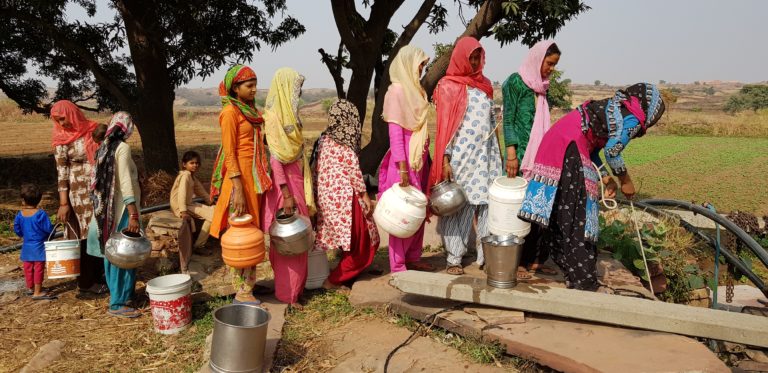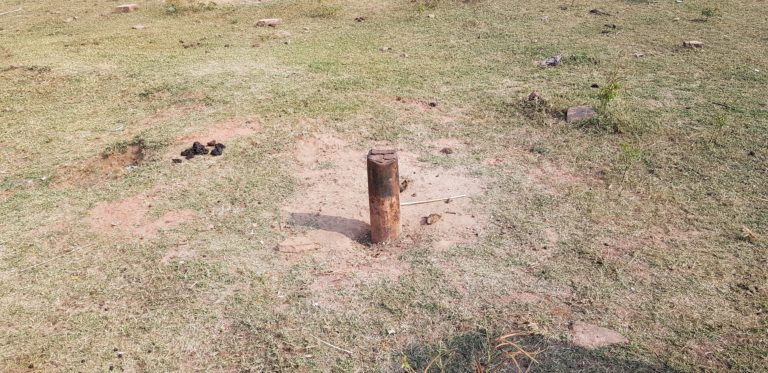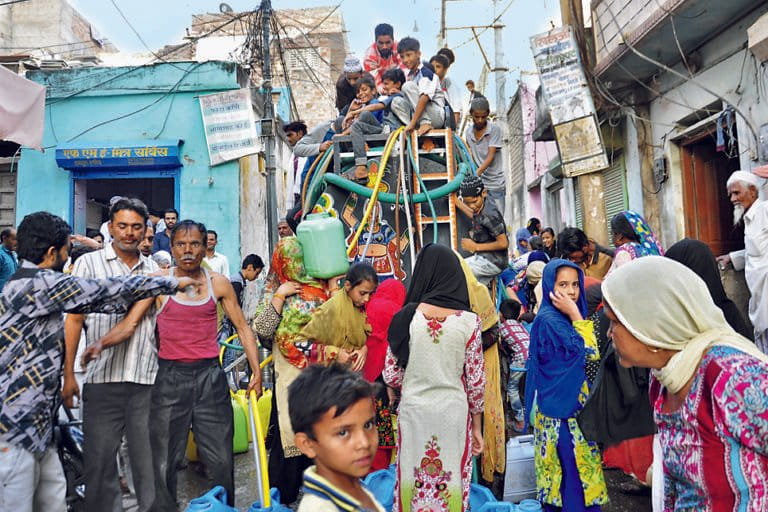- Rajasthan is India’s largest state with nearly 11 percent of the country’s land but access to only two percent of the national water. More than half of the state is under severe water crisis and a sustainable solution is one of the main demands of the voters across the state which goes to polls on December 7.
- Mongabay-India travelled to Rajasthan and found that in nearly every district, shortage of water is a significant issue and fights over water are common. However, some success stories of community efforts for water conservation are a silver lining.
- The ruling party BJP in its manifesto, has proposed a Rs. 370 billion project that will provide access to water for drinking and irrigation in 13 districts in Rajasthan. The Congress manifesto is also expected to address water access.
This is the first article in a two-part series on the role of environment in the upcoming elections in Rajasthan. Part Two will examine the issue of mining in the state elections.
Standing in front of his fields, eighty-year-old Raghubeer’s eyes well up and voice quivers as he speaks about the water scarcity in his village. In Kheda-Mandeli, a dusty hamlet in Karauli district of Rajasthan, people not only face an acute drinking water problem all through the year but also suffer from regular crop failures due to non-availability of water.
“We are facing a lot of difficulties. Now you see the wheat crop is standing and it will soon perish (because there is no water). What can we do? Now we don’t get work as labourers and agriculture is not possible here. The children go out of the village to earn a living and we are left here to suffer,” said a distraught Raghubeer.
In this parched land of Rajasthan, women walk miles in the scorching heat, to fetch water for their homes. In Shahanpur village, a few kilometres away from Kheda-Mandeli, women queue up in front of a well for hours. It is a long wait before their turn comes as this well is the only source of water for all needs of humans and cattle. Besides, the villagers depend on this well for all the irrigation requirements as well.
“My house is more than a kilometre away from here and sometimes we have to wait for as long as two-three hours standing in the queue. We have to make four to five rounds to fetch enough water for our home. No one has made any efforts to mitigate the problem though netas (politicians) promise to help us every time during polls,” said 20-year-old Rizwana.

This is not just one village or one district facing water scarcity. More than half of Rajasthan is under severe water crisis. At a time when politicians gear up for elections and promise people to mitigate all their woes, the one demand which resonates across the state is – water.
Mongabay-India travelled across Rajasthan and in nearly every village people narrated the tales of what they go through everyday and how the political leaders have failed to keep their consistent election promises of solutions for the water problem.
Five states – Rajasthan, Chhattisgarh, Telangana, Rajasthan and Mizoram – go to polls in November and December this year. The polls for the 200 seats of the Rajasthan legislative assembly are on December 7. The counting of votes for all the five states will take place on December 11. Rajasthan is also significant for the ruling Bharatiya Janata Party as 2019 parliament elections are just few months away. It accounts for 25 parliamentary constituencies.
“This government is blind. It can’t see our pain,” said an anguished Raghubeer. “They (political leaders) come and promise once in five years but hardly care about us after the election is over. Only God cares about us because when it rains, that is the only relief for people.”

Raghubeer, 80, from Kheda-Mandeli in Rajasthan speaks about the water crisis in his village and what the elections mean to him. Interview and footage by Hridayesh Joshi.
Government claims synergy across departments key in successful schemes
Rajasthan is India’s largest state with around 11 percent of the country’s total land. It supports six percent of the country’s population but it has got less than two percent share of national water. The state government, however, boasts of many programmes touting particularly the “Mukhyamantri Jal Swavlamban Abhiyan” (MJSA) as a major welfare scheme. It was launched in 2016 for better water conservation and management and has a target of reaching more than 21,000 villages in four years. The MJSA scheme claims to have covered 4,240 villages and 123 cities in its third phase alone in 2017-18. Officials say that a “synergy” across the departments has worked towards the success of the programme.
“Since concentrated efforts are always beneficial and yield better results than individual efforts, it has worked. Earlier, every department (involved in water conservation programmes) was implementing its own schemes. Now, this is perhaps for the first time all the departments have come together and are working for the purpose,” said Shashi Shankar Pathak, who is deputy conservator of forest, Karauli.
Earlier this year, a report by NITI Aayog , the central government’s policy-making body, clearly stated that more than 600 million people face high to extreme water stress in India. However, NITI Aayog in its report reveals that Rajasthan has improved in some indicator themes of water index like participatory irrigation and source restoration but overall it places the state under the category of “low performers”. NITI Aayog report also states that Rajasthan hasn’t drafted any regulatory framework for groundwater management and the state lags behind in establishing integrated water data.
As a result, the people on the ground are suffering and even migrating from villages to towns. “There are several problems surrounding us but it is the scarcity of water which makes life unbearable. We get a little relief only when the rain falls but after January the water level starts going down and then we have to live with no water situation.” said 62-year-old Abdul Kadir, who is one of the few elderly people left in his village, Shahanpur.
A similar sentiment is reflected by many others including 58-year-old Sukhibai of Saklupura in Karauli district, who walks more than 10 kilometres for water everyday with her grandchildren. “There is a little water in the well which we use to drink. A river flows nearby where animals drink water and we wash our clothes. But as summers come the stream dries up and the groundwater disappears,” said Sukhibai.

However, the collector of Karauli, Abhimanyu Kumar flatly denies when asked about the problems faced by these villagers. “There is no water problem in this area. We have several programmes like Chambal-Nadauti water supply project and it (the water) is available to all.” However, after persistent queries about the plight of the people on the ground, the collector acknowledged that “there may be a little problem during summers”.
Water scarcity is a problem across the state
There is a similarity and a contrast together in the rural and urban landscape of Rajasthan. Though the villages are emptying and cities are cramming with population, both urban and rural areas face water problem. On one hand the villagers trudge miles to fetch a couple of buckets of water, on the other hand urban water supply is also reducing day by day.
For instance, at present more than 80 percent of water supply to the capital city of Jaipur comes from the Bisalpur Dam which is built on a rainfed river, but given the rising demand, even the dam may soon run out of water. Due to poor rainfall this year, the Public Health Engineering Department (PHED) of the Rajasthan government has already reduced the duration of water supply to urban households and the situation may turn even worse after March as the dam also caters to other districts including Tonk and Ajmer.
Pressed with population growth and the influx of people, cities are expanding their boundaries but with limited resources and the government departments are finding it hard to cope with the situation. For instance, around 500,000 people in Jaipur are not covered by PHED’s pipeline water supply. They are dependent on hand pump and tube wells or tanker supply of water. Either people have to stand in a long queue to get a bucket of water or they purchase it at a price of almost Rs. 13 per litre by tanker supply.
Fights over water are frequent and often people lock water for the fear of theft. Moreover, the PHED’s tap water supply in the cities is now reduced to 30 to 40 minutes per day. Recently, in Ajmer, shopkeepers, government employees and trade unions launched a “No Water, No Vote campaign” which reflects people’s frustration and anger.

Leaders of incumbent BJP highlight the government schemes for water supply and say that the party will step up its efforts for water availability to all if voted to power. The BJP District President from Karauli, Ramesh Rajoria said, “Our Karauli district is very dry and rocky land. It is a mine area. I acknowledge there is a water problem here, but our chief minister launched the “Mukhyamantri Jal Swavlamban Yojana” which has helped a lot and the water table has improved. Our government has planned a scheme called Eastern Rajasthan Canal Project (ERCP) which we have sent for the prime minister’s approval.”
The BJP manifesto for Rajasthan which was released on November 27, states that the proposal for the ERCP, which will address the water issue in 13 districts and provide access to water for drinking and irrigation in the deprived villages, will be presented to the Central Water Commission on priority.
Leaders of the opposition Congress party however, squarely put the blame of the water crisis, on the ruling BJP party and water-related commitments are also expected in their upcoming manifesto. “We have got the issue (of water scarcity) highlighted in our manifesto and we are committed to solve the problem. Chambal has enough water and we will make it reach people,” said Darshan Singh Gurjar sitting MLA and Congress candidate from Karauli.
Water conservationist and environmentalist Rajendra Singh is not convinced. “Government schemes have totally failed. They haven’t made any sustainable effort to provide water to people in villages and this has caused the migration to cities. All the schemes and planning of government are around contractors they are benefitting them only. Now rural people have no way but to leave the village and in urban areas people are left at the mercy of tanker mafia,” said the activist from Rajasthan, who was has been awarded the Magsaysay award and Stockholm Water Prize for his efforts of water conservation.
The problem is compounded by rampant deforestation and mining in the ecologically important Aravali and Vindhya region. Despite the Supreme Court orders, illegal mining hasn’t stopped in Aravali and the construction business has mushroomed in the last decade. Though many apartments are lying empty as the real estate bubble has burst and there is no real buyer but an almost irreversible damage to greenery has caused water table to fall down rapidly.
“We have dug 273 more tubewells to cater the increasing demand in the city of Jaipur but even with the present plans and resources, we can hardly meet the requirement (of the projected population) till 2021. We will need more money and water if we want to meet the demand in future,” Dinesh Saini, who is PHED’s chief engineer, told Mongabay-India.
The silver lining
The thirsty and arid land of Rajasthan is also dotted by a few success stories written by community efforts. Maharajpura village in Karauli district is one such oasis of hope where a vast pond is built by rainwater harvesting. In 2012, with the help of an NGO Tarun Bharat Sangh, villagers of Maharajpura built a 68 feet high mud and concrete wall that prevented the rainwater from going waste. Now slowly the pond has spread to around 50 hectares and today more than 100 families are directly benefitted by its water in the 1.5-kilometres periphery.

“Six years ago, we had no water to drink or irrigate our field. That was a very difficult situation. Then we collected money from every house to build this wall. As the pond filled up, the water table in this area also improved. Today we have drinking water and we also grow mustard, wheat, and several vegetables in our fields,” said a beaming 45-year-old Ramsahai, from Maharajpura who actively participated in the construction of the pond.
The villagers who were going to work in the store quarries from this village are now engaged in agriculture. They earn better and don’t suffer the health hazards of mining. “This is the natural way to recharge the water bodies and improve the water table. Unfortunately, the government isn’t encouraging these efforts much,” said Chaman Singh of the Tarun Bharat Sangh, which works for empowerment of communities and sustainable development.
